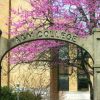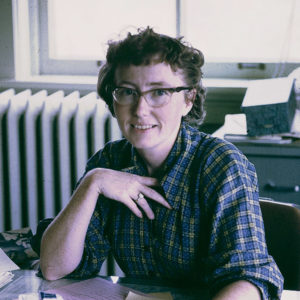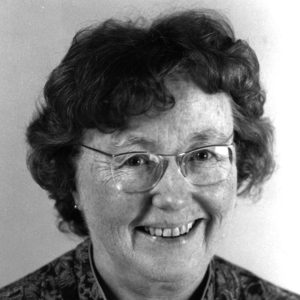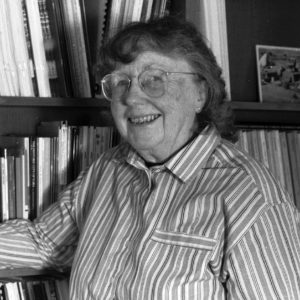calsfoundation@cals.org
Hester Ashmead Davis (1930–2014)
Hester Ashmead Davis was an internationally known archaeologist, administrator, writer, and professor. She was Arkansas’s first state archaeologist, serving from the creation of the position in 1967 until her retirement in 1999. She was among the first academically trained archaeologists working in Arkansas. She took an unconventional route to a career in archaeology at a time when few employment opportunities existed for women in the field. The centerpiece of her career was teaching and educating the public about archaeology. With Charles R. McGimsey III, she cofounded the Arkansas Archeological Survey in 1967.
Hester Davis was born on June 4, 1930, in Ayer, Massachusetts, to Edward Mott Davis and Dorothy Canning Thomas Davis. She was the youngest of five children. Her father was a 1909 Harvard University graduate with a BA in natural sciences. He managed the family apple farm in the community of Shirley, Massachusetts. Her mother was a homemaker. The family spent winters in Florida, where Hester’s father taught at Rollins College in Winter Park.
Davis came from a family of distinguished scholars and social activists. She was a direct descendant of Lucretia Mott, Quaker abolitionist and founder of the American women’s rights movement. Her grandfather, William Morris Davis, is considered to be the father of American geography as a scholarly discipline. He taught and did research at Harvard University for more than fifty years.
Davis’s first experience with archaeology was during the summer of 1939, assisting her brother Mott (then a Harvard graduate student) in excavations at Awatovi in northeastern Arizona. Her sister Penny, a graphic artist at the Peabody Museum (Harvard University), and her brother Mott encouraged her to participate in the Peabody Museum’s Upper Gila Expedition in New Mexico, where she met Bob McGimsey (also a Harvard graduate student). In 1952, she accepted a crew position on the River Basin Survey in North Dakota, becoming the first woman to work on a Smithsonian archaeological project.
Graduate studies at the University of Oregon during 1952–53 did not work out, owing in part to the reluctance of many academics to train female students, so Davis transferred to Haverford College in Pennsylvania to participate in a postwar graduate program that provided training in cross-cultural communication for development work in war-torn countries. Upon completion of her degree in social and technical assistance, Davis did not find overseas work but participated instead in ethnographic fieldwork among the Cherokee in North Carolina. This led to application for admission to the University of North Carolina’s MA program in anthropology, where she was accepted and then awarded a degree in 1957 based on her thesis, “Social Interaction in the Big Cove Community.”
From North Carolina, Davis moved to the University of Iowa for an applied anthropology position to investigate medical knowledge in rural farming communities. Disappointed in her ethnographic skills, she returned to archaeology by volunteering to work on a variety of local projects. Attending the American Anthropological Association meeting in the fall of 1957, Davis ran into Bob McGimsey, en route to a new job in Arkansas, to whom she expressed an interest in further archaeological employment.
Hired by McGimsey as a preparator at the University of Arkansas Museum two years later, Davis began teaching a museum methods classes in the Department of Sociology and Anthropology the following year at the University of Arkansas (UA) in Fayetteville (Washington County). She was promoted to associate professor in 1972 and professor of anthropology in 1978. From 1974 to 1991, Hester taught a popular class in public archeology that trained scores of practicing archaeologists. She also served as assistant director of the university museum from 1963 to 1967.
Hester also worked with McGimsey to establish a statewide archaeology program to promote greater public involvement. This led to the creation of the Arkansas Archeological Society (for avocational archaeologists) in 1960 and, in 1967, the Arkansas Archeological Survey. Davis continued to work with McGimsey for more than twenty years, playing a fundamental role in the development of the fields of public archeology and cultural resource management. While McGimsey devoted his primary efforts to working with state and federal legislators, Davis operated in tandem by publishing a series of articles in key archaeological and scientific journals to promote their shared vision of a professional-public partnership to expand the contribution of archaeology in American society.
With the creation of the Arkansas Archeological Survey, and following her appointment as Arkansas State Archeologist, one of Davis’s major legacies is the work she performed in overseeing the development and growth of the Arkansas Archeological Society. An important element of the Survey-Society partnership is the annual training program, held every year for two weeks in June, during which avocational archaeologists receive field and lab experience working side by side with the professional staff, with options to enroll in short courses on a variety of specialized topics. From the beginning of this program in 1964 to her retirement in 1999, Davis played an important role in organizing the logistical and educational elements of every training program during that interval. She also served as editor of the society’s two publication series, Field Notes and The Arkansas Archeologist, for most of her career in Arkansas.
Davis also played an important role in crafting the archaeology profession’s message concerning the importance of archaeology to the wider society and the corresponding need to cultivate broad public support. As part of this effort, she participated in numerous state, national, and international boards and committees, and served as an officer for many professional organizations, including serving as president of both the Southeastern Archaeological Conference and the Southeastern Museums Conference. She also served thirty-one years on the Arkansas State Review Board for Historic Preservation (including stints as vice-chair and chair), with successive appointments from seven governors.
Davis was a member of the U.S. Committee for the International Council on Monuments and Sites, and she was appointed by President Bill Clinton to the Cultural Property Advisory Committee of the U.S. Department of State.
Davis was the recipient of many awards and honors, including honorary doctorates from Rollins College and Lyon College in Batesville (Independence County), a Certificate of Honor from the American Society for Conservation Archaeology, Distinguished Service Awards from the Society for American Archaeology and the Society of Professional Archeologists, the Seiberling Award for Public Service from the latter organization, a Lifetime Achievement Award from the Southeastern Archaeological Conference, and a Conservation and Heritage Management Award from the Archaeological Institute of America. Her favorite award was the “Best Damn State Archeologist Award” that she received from the National Association of State Archeologists upon her retirement in 1999.
During retirement, Davis wrote Remembering Awatovi: The Story of an Archaeological Expedition in Northern Arizona, 1935–1939 (Peabody Museum Monographs, Cambridge, Massachusetts), which won the Independent Publishers 2009 IPPY Book Award (Gold) for Best Regional Non-fiction.
At the time of her retirement in 1999, Davis endowed the Davis Internship in Public Archeology at UA. This fund supports graduate students who plan a career in public archaeology. She also endowed the Hester A. Davis Research Fund at the Arkansas Archeological Survey. A group of longtime friends raised funds for a bench placed in her honor in Wilson Park in Fayetteville, across from her home. Posthumously, she was included in the inaugural group inducted into the Arkansas Women’s Hall of Fame in 2015.
Davis died on December 30, 2014, in Fayetteville. She is buried in the Quaker Meeting House Cemetery in South Yarmouth, Massachusetts.
For additional information:
Davis, Hester A. “The Crisis in American Archaeology.” Science 175 (1972): 267–272.
———. Training and Using Volunteers in Archaeology: A Case Study from Arkansas. Archaeological Assistance Program Technical Brief 9. Washington DC: U.S. Department of the Interior, National Park Service, 1990.
Davis, Hester A., contributing editor. A State Plan for the Conservation of Archeological Resources in Arkansas. Research Series 21. Fayetteville: Arkansas Archeological Survey, 1982.
Early, Ann M. “Hester Ashmead Davis.” In Encyclopedia of Global Archaeology, edited by Claire Smith. New York: Springer, 2014.
“In Memoriam Hester Davis—A National Treasure.” Archaeological Conservancy. https://www.archaeologicalconservancy.org/memoriam-hester-davis-national-treasure/ (accessed December 15, 2022).
Little, Barbara J. “An Interview with Hester Davis.” CRM: The Journal of Heritage Stewardship 6 (Summer 2009). https://www.nps.gov/crps/CRMJournal/Summer2009/interview.html (accessed December 15, 2022).
White, Nancy M. “Hester A. Davis, a Legend in Public Archaeology.” In Grit-Tempered: Early Women Archaeologists in the Southeastern United States, edited by N. M. White, L. P. Sullivan, and R. A. Marrinan. Gainesville: University of Florida Press, 1999.
White, Nancy M., Rochelle A. Marrinan, and Hester A. Davis. “Early Women in Southeastern Archaeology: A Preliminary Report on Ongoing Research.” In Women in Archaeology, edited by Cheryl Claassen. Philadelphia: University of Pennsylvania Press, 1994.
Kathleen H. Cande
Arkansas Archeological Survey
 Divergent Prosperity and the Arc of Reform, 1968–2022
Divergent Prosperity and the Arc of Reform, 1968–2022 Education, Higher
Education, Higher Hester A. Davis
Hester A. Davis  Hester A. Davis
Hester A. Davis  Hester A. Davis
Hester A. Davis 




Comments
No comments on this entry yet.